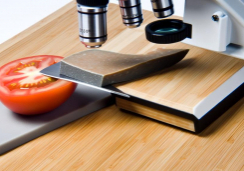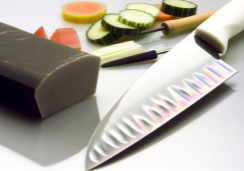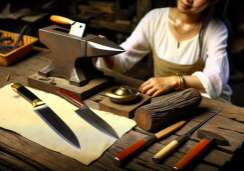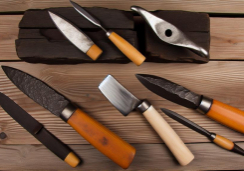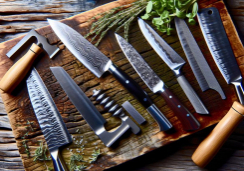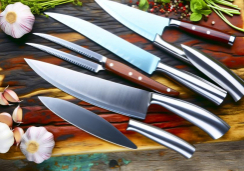Steps in Handcrafting Premium Kitchen Knives
In the dance of metal and fire, you become the choreographer, orchestrating the birth of a premium kitchen knife.
You start by selecting the steel, a critical choice that sets the stage for durability, sharpness, and resilience.
With the steel in hand, you move to the forge, where intense heat and precise hammering shape the blade's soul.
But it's in the nuanced art of shaping and grinding where your skills truly shine, sculpting edges that promise both precision and artistry.
As the heat treatment process tempers the steel, a transformation occurs, hardening the blade to withstand the rigors of a kitchen's ballet.
Just when the metal begins to sing with potential, you'll find that applying the final touches is a journey of meticulous craftsmanship.
Stay with me, and discover the secrets that elevate a mere tool to a culinary masterpiece, waiting to be wielded by the hands of a chef.
Selecting the Steel
The choice of steel is a critical foundation in the handcrafting of premium kitchen knives. It determines the blade's durability, sharpness, and overall performance. You'll want to delve into the metallurgical nuances that set superior blades apart.
The steel's carbon content is pivotal. High-carbon steels, like the revered VG-10 or the robust CPM-S30V, offer exceptional edge retention and resilience. However, they demand meticulous care to prevent corrosion.
You're not just looking for hardness; the elusive balance between hardness and toughness is paramount. A blade too hard may become brittle, while one too soft will dull swiftly. It's in this intricate interplay of elements such as chromium, molybdenum, and vanadium where you'll find the sweet spot for your knife's intended use. Stainless steels imbued with chromium offer rust resistance, crucial for professional kitchens or humid environments.
When you're selecting steel, consider the grain structure as well. Fine-grained alloys like AEB-L are renowned for their ability to be honed to a razor's edge. Forging temperature, quenching protocol, and tempering cycles all interlace to define the steel's final character.
Your discernment here sets the stage for a blade that's not only a tool but a masterpiece of craftsmanship.
Forging the Blade
Having selected the ideal steel with the perfect balance of carbon, chromium, and other elements, you'll now heat it to extreme temperatures to begin the forging process, meticulously hammering and shaping the blade into a kitchen tool of unparalleled quality. Your forge, glowing at around 1,100 to 1,200 degrees Celsius, will bring the steel to a state of high malleability. With precision, you'll place the billet within the fiery heart until it radiates a bright, incandescent orange.
Upon reaching this critical temperature, you'll retrieve the steel with tongs and lay it upon the anvil. Here's where your skill truly shines. The hammer falls, its weight guided by your experienced hand, compressing the steel, refining its grain structure. You'll work in harmony with the metal's rhythm, folding and welding, ensuring an even distribution of carbon for a durable edge retention.
You'll maintain a scrupulous eye for temperature, never allowing the steel to cool too much during shaping—this could cause cracks or weaken the blade. The process, a symphony of heat, force, and expertise, forges a blade that's both resilient and razor-sharp. Each strike, a step closer to achieving the quintessential geometry, culminates in a kitchen knife that's as much a work of art as it's a culinary instrument.
Shaping and Grinding
After forging the blade to its rough shape, you'll next turn to the grinder—where precision and patience transform the steel into a blade of exceptional sharpness and finesse. You'll need to choose the right grinding wheel—perhaps a ceramic or aluminum oxide abrasive, known for their durability and fine finish. The wheel's grit size is critical; start with a coarser grit to remove excess material quickly, then gradually switch to finer grits for a smooth, polished edge.
As you approach the grinder, hold the blade firmly, presenting it to the wheel at the precise angle that befits the knife's purpose. A chef's knife, for instance, requires a different angle than a paring knife. Steady, controlled movements are paramount to maintaining uniformity along the blade's edge. You're not just grinding metal; you're sculpting a tool that must perform flawlessly under the rigors of kitchen use.
Cool the blade intermittently to preserve the steel's temper. Overheating can weaken the blade, leading to a loss of hardness or, worse, warping the metal. After the initial shaping, you'll refine the edge with honing rods and strops, imbuing your knife with a razor-sharp finish that reflects your meticulous craftsmanship.
Heat Treatment Process
Once you've sculpted the knife with grinding precision, heat treatment awaits to further enhance the steel's structure, granting your blade the resilience it needs for a lifetime of cutting. This critical phase involves a meticulous balance of temperature and timing, tailored to the specific alloy you're working with.
Begin by gradually heating your blade in a specialized furnace, aiming for the austenitizing temperature that will transform the steel's microstructure. This is a moment where precision is paramount—too hot and the steel may burn, too cool and it won't harden properly. Monitor the temperature vigilantly, using pyrometers to ensure accuracy.
Once the steel reaches the desired heat, it's time for quenching. Plunge the glowing knife into an oil or water bath, carefully chosen to match the steel's properties. This rapid cooling locks in hardness but also makes the blade brittle. To temper this fragility, you'll then reheat the knife to a lower temperature, allowing the formation of tough but flexible microstructures.
You'll carefully cool the blade once more, completing a transformation that imbues your knife with a harmonious balance of hardness and toughness, ensuring that it can withstand the rigors of the kitchen while maintaining a keen edge. This is the art of heat treatment—a dance of fire and steel.
Applying the Final Touches
Polish the hardened blade to a mirror-like sheen, ensuring each stroke of the whetstone reveals the meticulous craftsmanship of your work. Start with a coarse grit stone, methodically refining the edge. Progress through increasingly finer grits, each pass refining and honing the steel's surface. The blade's bevel should be consistently polished, revealing the convergence of form and function in your handiwork.
Next, attend to the handle. Select materials that complement the blade's aesthetic and ergonomic needs. Shape the handle with care, sanding it down to a smooth finish that fits comfortably in the user's grip. Secure it to the tang using high-quality rivets or a strong epoxy, ensuring a seamless join that won't falter under pressure.
Etch your maker's mark into the steel—a signature of authenticity and pride. It's not just a brand; it's a testament to the quality and individuality of the knife.
Finally, oil the blade and handle, protecting the metal and wood from moisture and wear. This not only preserves the knife's condition but also enhances its tactile and visual appeal.
Your knife is now a paragon of precision and artisanship, ready to take its place in the most discerning of kitchens.
What Makes Handcrafted Premium Kitchen Knives Ideal for Vegetable Chopping?
Handcrafted premium kitchen knives are the best knives for vegetable chopping due to their precision, durability, and sharpness. Their high-quality materials and expert craftsmanship ensure seamless and effortless cutting, allowing for perfect slices and dices every time. The superior design and construction make them an ideal choice for any home chef.
Conclusion
You've meticulously chosen the finest steel, skillfully forged and shaped the blade. With precision grinding and a rigorous heat treatment, your knife's edge has been honed to perfection.
Now, as you apply the final touches, you're not just finishing a tool; you're crafting a masterpiece. The balance, the grip, the sharpness—every detail reflects your technical prowess and artisanal passion.
This isn't just a knife; it's an extension of the chef's hand, a testament to your craftsmanship.

